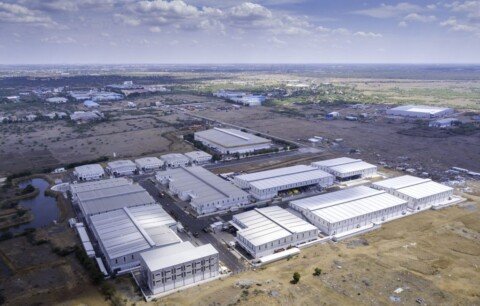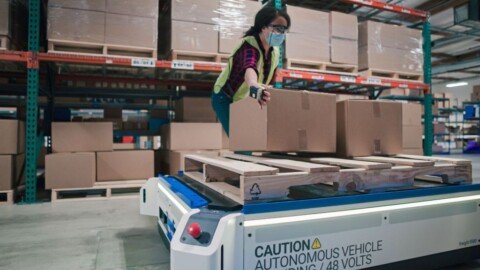The emergence of the new type of virus at the end of 2019 put significant pressure on the pharmaceutical industry. For the first time in the world’s history, the global pharma industry witnessed the daunting challenge of distributing medical equipment, PPE kits, vaccines and other critical drugs to as many people in the world as quickly as possible. Alongside this, they also needed to ensure that regular production of other medicines was able to continue to ensure treatments for other conditions were not impacted. Importantly, the rollout of COVID-19 vaccines was an elephantine task like no other full of potential pre- and post-production challenges. But to everyone’s surprise, the global pharma industry successfully combated all of those and proved its mettle—be it rigorous clinical trial programmes to confirm protection against SARS-CoV-2 virus in humans with the invention of vaccines, determining the best form of storage and transportation measures with the right cold chain strategies in place, then scaling up production up till now—thorough risk assessments and reviewing supply chain procedures that are key to building resilience.
Ritika Arora Bhola
Aside from responding to the immediate threats of the pandemic, pharma organisations had to adapt quickly to ensure that they can be resilient to disruption and work in more agile ways, both in a post-COVID environment and in preparation for a possible second wave of the virus. Preparing for multiple possible scenarios became the key to ensuring continuity and the management of risk no matter the situation.
Almost every pharmaceutical company started following suit during the COVID-19 pandemic, and using their own production and supply chain capabilities, tried to lighten the burden of coronavirus on people. GlobalData expects that each pharmaceutical company will find its own unique manufacturing and distribution strategy, as not doing so could lead to detrimental effects on reputation.
“Continuity in services and supplies related to healthcare industry become most crucial in a pandemic of such magnitude, which leads to great amount of pressure on pharma and healthcare supply chains. No doubt, the pharma industry has shown great amount of resilience while responding to such situation,” agrees Vikash Khatri, Founder, Aviral Consulting.
The intricacies of the pharmaceutical supply chain may not have been in the mainstream news a decade ago, but events of the last few years kicked this subject to front page news.
Prior to the pandemic, the industry faced immense pressure to police its own pricing irregularities and link its business results to public health. Another aspect of the industry that the pharmaceutical companies could not gain a hold of was consumer demand prediction, even before the pandemic struck. While it might seem strange for a sector rooted in daily medications and prescriptions to have issues with demand planning, this problem perplexed care providers and manufacturers.
Like other industries in the supply chain, the trends in the pharma supply chain pushed technology innovation and adoption but it is the COVID-19 crisis that made this more prominent. Understanding patient behaviors was considered an impossible dream, but newly integrated platform technologies are making this achievable.
Today, an ongoing industry effort across nations to rebalance the pharmaceutical supply chain is being energised by their respective government’s initiatives to ensure more domestic production of drugs and investment in digital transformation and automation that have become only more important and immediate as companies re-evaluate their supply chain solvency.
“COVID is once in a lifetime scenario but I would say there are so many instances that can disrupt the supply chain. I agree its country specific, but every continent/geography faces unforeseen circumstances that may occur at any given time. In my opinion, these challenges give us an edge to make supply chains shock proof, i.e. remodeling it so as to ensure minimal impact of the external environment,” says Bharat Bhushan Rathi, Head of Logistics at Mankind Pharma.
“Importantly, if we are in the lifesaving drugs manufacturing sector, then it’s rather more important as risk are associated with human life and not just limiting to business continuity. We need to continuously evaluate our approaches to debottlenecking and process optimisation which gives a competitive advantage in the market.”
“From the last few months, major economies are now driving self-sufficiency agenda and recalibrating their global business models as COVID-19 has led to significant geo-economic and geopolitical shifts,” says Tushar Jani, Group Chairman at Cargo Service Centre.
“With vaccines and pharma becoming the need of the hour, the spotlight was turned on the pharma industry and by extension to the cold supply chain. No one thought the pharma industry would exhibit such capabilities, but since the players were determined to perform, the outbreak was not able to hinder progress. The pharma industry was quick to adapt to the changing demands and new restrictions. Building a more robust supply chain aided by the latest technology has been a major achievement.”
“Like every other, we also have had to review the way we did business and were put to test. But I am proud to say, we at Mumbai Cargo Service Centre Cold Chain Solutions Pvt Ltd (MCSCCCSPL) alone have handled thousands of tonnes of pharma cargo of which 72 million were COVID-19 doses.”
“There are enough reasons to believe that the existing supply chains have done a commendable job in transporting the pharma raw materials, FG medicines and medical equipment, and other formulations and aid right in time. Air and surface networks did very quick adaptations for transporting pharma goods which included deployment of passenger aircraft as freighter on domestic and international routes for carrying cargo on cabin and seat apart from the belly. A whole lot of reefer and regular trucks operated with pharma goods amid the harsh nationwide lockdowns, while the warehouses operated smoothly to support every possible movement,” says Gaurav Ghuwalewala, Director ofIndia-basedforwarding company EDS International.
“And, to be more specific, the pharma supply chains in India may be technologically nascent, but they are very adaptive and quickly evolved to respond and offer in-time solutions.”
Exploiting opportunities to Boost Performance of India
The Indian pharmaceutical and healthcare supply chains have been under the ‘Limelight’ ever since the COVID-19 crisis hit. The disruptions in the country’s healthcare supply chains are absolutely undesirable, as these supply chains are the singular saving grace for the supply of medical equipment, life-saving drugs, and today, COVID-19 medical essentials, oxygen concentrators, and vaccines in the world’s second populous nation and a rapidly growing sector that is on way to become global pharma hub.
Practically, there have been certain critical gaps and challenges which the Indian pharma supply chains had to overcome at short notice, most notably—inadequate cold chain infrastructure and transportation facilities, market fragmentation, lack of technology intervention and upgradation, apart from trained manpower.
Pharmaceutical cold chain management is an important aspect of the supply chain in the healthcare industry. The cold chain logistics services help the pharmaceutical and healthcare industries maintain a continual stock of drugs from suppliers and distributors across varied locations. The life of a lifesaving medicine can come to an end without proper preservation. What role medicine plays for human life, the same role is played by proper storage for a medicine.
“The cold supply chain sector is one that requires heavy investments. And this is something that not many logistics providers are ready to do,” Jani says, as he reassess the major impediments which have traditionally been existing in the Indian pharmaceutical cold supply chain and needs an urgent makeover.
- Supply chain maturity (assets as well as ways of working through wholesalers and clearing and forwarding agents) needs to evolve to cater to market needs
- Quality and compliance processes need to be enhanced and standardised across the value chain
- Specialised cold chain requirements for vaccines and other complex formulations which if unavailable can significantly increase supply chain costs
- More supply chain transparency in terms of tracking, delays and physical condition of the cargo
Ghuwalewala also hints at the major challenges prevailing in the pharma and cold supply chain which needs immediate attention.
“The overall cold supply chain is comprised of a large number of small players who have technology issues and also are not updated with latest trends. They also lag in capital investment into technology.”
“Production by pharma companies is fragmented into many zones which are far away from cities and airports, thereby increasing the complexities. Meanwhile, there are infrastructure issues at airport facilities. The ever increasing product list and different requirements of product categories adds to the complexities that exist at warehouses and within transport systems. Power outages are already a threat to maintaining cold storages, and monitoring of temperature excursions in cold chain movements is a serious problem.”
“Also, many of the pharma raw materials/chemicals are regulated under DGR. Many times, these cannot be transported or are subject to additional regulations which many transporters are not aware of and updated.”
“India being a prominent generic manufacturer of pharma does have a mature pharma supply chain, but on the upstream side, excessive dependence on imports for API clearly indicates a concern for the industry. During initial days of the pandemic, the industry witnessed interrupted supplies of raw materials,” Khatri explains.
Meanwhile, on the domestic front, according to Khatri, downstream supply chain infrastructure is a challenge, especially at the last-mile level. “Most of the companies have very poor visibility post their CFA RDC/CFA level regarding both quality and quantity,” he says.
Technological advances, growth in supply and the ability to scale up or scale down the capacity will likely remain the key factors as long as the pharma supply chain remains. However, it goes without saying new areas, trends and initiatives will arise to predict the constant changing demands on infrastructure services.
So, the mainly question is how can India utilise the emerging opportunities to reorder its own domestic value chain network and emerge as a significant actor to allow more nations to become interdependent and associate with a large developing market?
India’s existing advantage of large-scale pharmaceutical production allows it to significantly leverage its soft power by investing in the outward growth of the healthcare sectors of other nations. It just requires close monitoring and planning of inventory levels, efficient storage and distribution processes, more tech embedment into processes and systems, and smoothing out the strains on last-mile capacity.
“The Indian pharma supply chain is evolving with each passing day but it still has a long way to go,” contends Bhushan.
“There is a gap in terms of lack of visibility/transparency across the value chain, i.e. real-time status is either not available or data sanctity which remains underutilised. Not only that, we have limited trained resources/manpower which make it even more difficult to survive. But, I see, as more and more professionals are now taking supply chain and logistics management as career, and technology startups joining the pharma industry, this gap is getting covered at a fast pace and in short time.”
Transparency and Market Fragmentation
India’s cold chain logistics market has been quite fragmented because of the presence of too many big and small players in the value chain to cater to the growing demand. And, serious consolidation is happening on this front from the last few years.
Jani highlights the same. “Some of the challenges in the market exist because of the lack of ownership or accountability due to fragmentation of the industry, inconsistent operating standards and conditions and the need for high capital investment.”
“One smart solution that have been implemented by bigger cold chain logistics companies is that they have tied up with hyper-local service providers and this has improved connectivity for them, while their local partners gets the taste of the technology and systems at play in the industry. This deal works for everyone. It’s a win-win situation.”
Ghuwalewala agrees and says, “Consolidation and more sizeable investments have happened in the recent years across the supply chain domain including in the pharma cold chain space. This includes warehousing, surface transport, and on-airport facilities.”
“With a slew of freighters being added in India, we will soon see consolidation in the air cargo supply chain as well.”
To the extent that competition fragments a market, regulators however need to consider the adequacy of the transparency arrangements as well as the necessity and ability to enforce the same whenever required. This is important not only to optimising scope of services but also for the maintenance of efficient practices. For instance, competition results in fragmentation that leads to significantly different transparency levels across the market and/or excessively high costs for market participants and their customers.
With a similar perspective, Khatri says, “Without any doubt, there are numerous smaller and unorganised players in the market. But at a business model level, we need to understand overall ecosystem and regulatory framework for their existence and success. Until effectuated, there cannot be any consolidation trend.”
Rathi says, “It’s not easy for one player to provide customised region-specific services, but yes, there is the need for one common platform which can standardise the services of all regional players. Something that will guarantee standardisation across all service providers and support for reliable and timely delivery of services.”
I don’t personally see there will be too much effect on consolidation of services as India is geographically diverse country,” he adds.
Continued expansion of Cold Chain Infrastructure
The pandemic has made the industry take a turn for the good. Pharmaceutical companies are now demanding more transparency while their shipments are in transit. This has led logistics service providers to look for facilities provide the required level of monitoring and tracking. This speaks for itself about the need of the industry to go beyond simply tracking the shipment. A thoroughly temperature-mapped facility that provides the stakeholders down the supply chain with information that ensures their products are safe.
Not only this, cold storage for pharmaceuticals requires high-tech equipment to meet the needs of different drugs. Even drugs that are safe at room temperature may need protocols to avoid the risks associated with ambient temperatures. Today, logistics providers receive more requests for controlled room temperatures (CRT) which include the use of insulated containers, refrigerants, thermal blanketing, and temperature-monitoring electronics.
CSC already has the right infrastructure in place and the TURANT-CSC application provides round the clock temperature and tracking details to customers.
“At MCSCCSPL, we are always on the lookout for options that will put our customers at ease that their shipments are being handled carefully. Our flagship tracking and monitoring app TURANT-CSC has been developed for this purpose. The entire facility has been temperature mapped to identify the hot spots and cold spots spread within. This is a time and effort extensive exercise. We took this exercise as a step forward and started monitoring the temperatures at these spots. We extended this visibility to our customers in real-time.”
“Over a period of time, share of pharmaceutical shipments requiring cold chain environment is increasing with more and more bio-similar drugs, but cold chain infrastructure in terms of standards to handle growing pharma shipments pose as a weak link in the overall supply chain,” says Khatri.
“Although India has 37 million sq ft of cold storage capacity, but out of this most of the capacity is for agri products and less than 1% is contributed for pharma industry.”
“Even in such small storage capacity, there are many weak links, where quality of infrastructure is not up to the mark. In case of transportation, situation is much worse at level of secondary distribution and last-mile. But, it’s a relief to see improvements in infrastructure around cold chain transportation and warehousing from the past few years,” adds Khatri.
Ghuwalewala says, “Consolidation and investments in surface network have also led to substantial cold chain warehouses being set up. In recent times privatisation of airports has led to many cargo complexes getting dedicated cold storages. But, still a lot of addition has to be done to match the infrastructure to the expectations of the pharma industry.”
Rathi takes into account the same. “In recent past, things have changed to a great extent as large amount of investments were floated in the sector. At present, we can say that we have sufficient resources available in A class cities and also infrastructure within B Class cities have improved, but a lot of work is still pending. To offer good healthcare facilities to the entire nation, companies need to penetrate further in B and C class cities, which I absolutely believe will be the future playground for all players.”
Future Forward
Pharmaceutical products are also highly susceptible to temperature and time constraints, making cold chain a key requirement for this industry. In the present scenario where safe delivery of vaccines for mass immunisation against COVID-19 is an absolute priority, the cold chain is in huge demand as evident.
Today, pharmaceutical manufacturers themselves have adopted an unwavering focus on quality and product sensitivity. Transportation, storage and delivery of temperature-controlled pharmaceutical products and medical devices are already witnessing considerable growth. With that, the entire cold supply chain and logistics for the pharmaceutical industry is becoming more strategic and reliable.
Furthermore, future trends in this sector would include built-to-suit (BTS) assets with superior building specifications, diversity in cold storage offerings catering to higher-value commodities and use of sustainable solutions for reducing operational costs.
While all of the above factors are key drivers for growth of the sector, largely brought about due to the global pandemic, the renewed push for manufacturing and vocal for local initiatives are going further to ensure there is a continuous impetus for growth, in the post-COVID era.
Rathi agrees. “State-of-the-art infrastructure that is an amalgamation point for trained manpower and intelligent systems that facilitates real-time visibility across the network with standard operational procedures for safety and reliability is the key to building a strong ecosystem, which needs to be backed by top-class service providers.”
“Today, with the entry of e-commerce, Indian logistics market has been changed drastically and with regards to pharma, a lot of investments have been made by both the government and global private investors, which is one of the biggest reasons that the Indian pharma market is estimated to reach US$150 bn by 2030, making it an even more lucrative area to invest,” he adds.
Last but not least, automation in warehousing and use of AI and ML enabled robotics processes to ensure efficacy and speed will be rapidly adopted by the service providers to fine-tune logistics management.
Ghuwalewala says the two major changes coming in the near future are—a lot of advanced technology integration to offer more real-time visibility which will ultimately bolster shipper’s confidence, and small to medium ULDs which will infuse ‘plug and play’ infrastructure for maintaining an efficient cold chain in pharma air freight.







